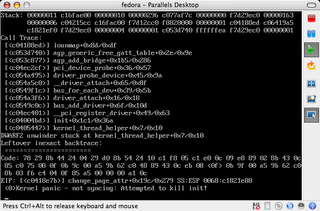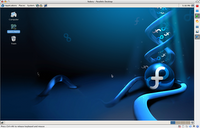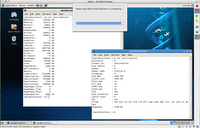Fedora Core 6 (Zod) in virtualized environment
I got to install Fedora Core 6 twice yesterday, in very different contexts, and I'm so far rather pleased with the outcome of my stay in Zod-land. This, despite minor setbacks which were very much due to my requirements, and some not truly Fedora related.
My first run with the new Core 6 was a clean install on a late 2006 Apple MacBook (2 GHz Intel Core Duo), virtualized through Parallels Desktop.
Not having had time to keep up with the beta phase this time around, I walked into this one head first with my eyes closed, so I wasn't expecting the process to be flawless, provided the environment I was facing.
Because of quasi constant network access and the availability of a very good regional mirror, my preferred way to install or upgrade my Fedora boxen is to proceed with a net install, starting from the minuscule, by today's standards, provided boot disc (boot.iso).
As an insight, Parallels will let you select the latter ISO disc image to act as your VM's CD/DVD drive, so that you can skip burning the boot disc to a removable media.
Launching the installer through a new Parallels VM, I was unfortunately immediately faced with a hurdle. Namely, I was getting what seemed to be a hardware detection related kernel panic at boot time. As it turns out, this was not Fedora specific, but is a known issue with the Parallels Desktop product suite.
A few web queries and a friend's wisdom quickly netted valuable results from the Parallels support forums technical discussions.
The problem was easily bypassed by setting the VM's memory settings to the very specific value of 512 MB of RAM. Good thing my laptop is loaded with 2GB, which I'll add is highly desirable for virtualization purposes.
For the record, I noticed that 256 and 924 MB also helped me get passed the early detection bug and into the Anaconda installer process, but only 512 would not revert back to a kernel panic on reboot once the install process was completed.
Since then, someone actually posted a Fedora Core 6 v. Parallels specific thread which you might also want to read through. I haven't had the chance to implement the proposed solution, and I'll admit that the lazy geek in me is ushering that 512 MB of RAM will be just fine for what I need to achieve in this instance.
Once this was all figured out, and I have to state that it was my first GNU/Linux install under Parallels, the install process was as straightforward as any I've ever been through (countless native and VMWare Workstation instances).
Two noteworthy additions to FC6's Anaconda, from a user's perspective, are the automatic retrieval of the latest version of the software you are installing, instead of the base version, and the optional selection of the Extras repository directly within the installer.
Unfortunately, I was not able to configure sound for my MacBook at install time, but I doubt this will be an issue for long, since it uses Intel's onboard audio and video chipsets, which are well understood and supported by the open source development community.
Finally, for a last very context specific issue, I faced something that wasn't a show stopper, but could have left some users perplex. During the installation, which I ran in windowed-mode (ie: not full screen), I continued to interact with OS X (browsing, etc), and therefore brought the mouse focus back to the host OS. But once the install procedure was complete within the VM, I was unable to focus the cursor back into Fedora to agree to the system reboot prompt. Again, I did not deem this to be more than an annoyance, because the point was to restart and I was able to do so via the VM console's reboot button, but this hiccup could have been more serious if Fedora had required further user input.
So on I went with the first boot, and the kernel and all of the desired daemons loaded without a hitch. I had chosen to go with a base install, to initially save time, which of course means that your mileage may vary, should you decide on a larger software selection. Historically though, it seems that most post-install boot related errors occur with the base system, more than the higher level add-ons, unless you chose to add core modules or such deep components through the Extras repository.
All went pretty much flawlessly from then on. Close to what I would expect running Fedora through dual-booting my Mac instead, which I'm sure has its own share of nitty gritty details.



One slight disappointment at this time is that despite the long list of guest OSes that Parallels Desktop for Mac supports, they do not provide a Linux version of their Parallels Tools, which help deliver customized hardware drivers to the virtualized operating system. I somehow find this puzzling, given that the documentation lists the now obsolete OS2 as being an option for these useful, but non mandatory, utilities. But I guess a dead OS is an easy one to support. :)
So to conclude, I won't bore you with a deeper usability and performance review of this proud and shiny new piece of OSS engineering, since you can find much more elaborate ones all over the Net (1, 2) but I'll soon post about my further toying with Fedora through a native FC5 to FC6 upgrade on x86 architecture with my home file/media/LAMP server.
And if you never dared taking the GNU/Linux plunge, now might just be the time, although you might also want to wait to hear about Edgy, the soon to be realeased next generation Ubuntu offering, which also promises to be a quality product.
Update 1: fixed a typo that led a funny comment on osnews.com. I also tried to address the OS2 part of the latter comment in a related comment below.
Update 2: I now have a similar virtual machine image for download, as well as a complete install screencast.
 Stephane Daury
Stephane Daury
6 comments:
Hmmm, Edgy is already released.
Download it here
As an OS/2 - eComStation user, I find the utilities VERY useful. Your linux may run on anything out of the box, but there are times when keeping good working old HW around just isn't as easy, or desired. Many places still use Os/2, and having the ability to carry ONE laptop onsite is great.
I understand your desire to have them available for linux. Id' like to see them as well. but you were also right in stating that an older OS (not dead yet) is easier te develop for. It's not the moving target that linux is, and it's well documented on what needs to be done.
Adam, I admit my overly morbid wording might have left you cold. What you voiced (dynamic target v. static one) is precisely what I implied. Put the death thing on Halloween approaching. ;)
PS: or at least what I meant to imply.
Ken: it feels as if they were releasing Edgy Heft as I was posting this article... :) It wasn't out as I was editing it (same day), but was by the time I checked again a few hours after I went live.
Someone posted a work around on the parallels Forums for the memory bug cited above:
Workaround for memory bug (fedora core 6)
Post a Comment